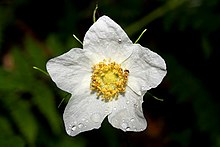Rubus parviflorus
| Rubus parviflorus | |
|---|---|

| |
| Scientific classification | |
| Kingdom: | |
| (unranked): | |
| (unranked): | |
| Order: | |
| Family: | |
| Genus: | |
| Subgenus: | Anoplobatus
|
| Species: | R. parviflorus
|
| Binomial name | |
| Rubus parviflorus | |
Rubus parviflorus, commonly called thimbleberry,[1] is a species of Rubus, native to western and northern North America, from Alaska east to Ontario, Washington and Michigan,[2] and south to northern Mexico. It grows from sea level in the north, up to 2,500 m (8,200 ft) altitude in the south of the range.
It is a dense shrub up to 2.5 meters (8.2 ft) tall with canes no more than 1.5 centimeters (0.59 in) in diameter, often growing in large clumps which spread through the plant's underground rhizome. Unlike most other members of the genus, it has no prickles. The leaves are palmate, up to 20 centimeters (7.9 in) across, with five lobes; they are soft and fuzzy in texture. The flowers are 2 to 6 centimeters (0.79 to 2.36 in) in diameter, with five white petals and numerous pale yellow stamens. The flower of this species is among the largest of any Rubus species, making its Latin species name parviflorus ("small-flowered") a misnomer.[3] It produces a tart edible composite fruit around a centimeter in diameter, which ripen to a bright red in mid to late summer. Like other raspberries it is not a true berry, but instead an aggregate fruit of numerous drupelets around a central core. The drupelets may be carefully removed separately from the core when picked, leaving a hollow fruit which bears a resemblance to a thimble, perhaps giving the plant its name.[4]
The species typically grows along roadsides, railroad tracks, and in forest clearings, commonly appearing as an early part of the ecological succession in clear cut and forest fire areas.
Ecology

Thimbleberry is found in forest understories with typical flora associates including coastal woodfern, Dryopteris arguta, Trillium ovatum and Smilacina racemosa.[5]
Uses
Thimbleberry fruits are larger, flatter, and softer than raspberries, and have many small seeds. Because the fruit is so soft, it does not pack or ship well, so thimbleberries are rarely cultivated commercially. However, wild thimbleberries can be made into a jam which is sold as a local delicacy in some parts of their range, notably in the Keweenaw Peninsula of Upper Michigan. Thimbleberry jam is made by combining equal volumes of berries and sugar and boiling the mixture for two minutes before packing it into jars. The fruits can be eaten raw or dried,[6] but they are not always very palatable.[7] Many parts of the plant were used for a great variety of medicinal purposes by Native Americans.[6][8]
The Concow tribe calls the plant wä-sā’ (Konkow language)[9]
Thimbleberry plants can be propagated most successfully by planting dormant rhizome segments, as well as from seeds or stem cuttings.
A double-flowered form of the thimbleberry was discovered near Squamish, BC, by Iva Angerman (1903–2008) of West Vancouver, BC.[10] This clone does not appear to be in commerce, but is grown in the Botanic Garden of the University of British Columbia, Vancouver, and in the Native Plant Garden of the Royal British Columbia Museum, Victoria. Another double-flowered thimbleberry was found about 1975 by Bob Hornback on Starrett Hill, Monte Rio, California and given the cultivar name 'Dr. Stasek', after an art instructor at Sonoma State University. This clone is sold by one nursery online.[11]
Cultivars of the plant are used for ornamental purposes, bred for their fragrant flowers and attractive fall foliage.[8]
References
- ^ Bailey, L.H.; Bailey, E.Z.; the staff of the Liberty Hyde Bailey Hortorium (1976). Hortus third: A concise dictionary of plants cultivated in the United States and Canada. New York: Macmillan.
{{cite book}}: CS1 maint: multiple names: authors list (link) - ^ U.S. Department of Agriculture. 2009. Rubus parviflorus Nutt.
- ^ Lady Bird Johnson Wildflower Center
- ^ Rook.org
- ^ C. Michael Hogan. 2008. Coastal Woodfern (Dryopteris arguta), GlobalTwitcher, ed. N. Stromberg
- ^ a b Ethnobotany
- ^ USDA Species Fact Sheet
- ^ a b US Forest Service Fire Ecology
- ^ Chesnut, Victor King (1902). Plants used by the Indians of Mendocino County, California. Government Printing Office. p. 408. Retrieved 24 August 2012.
- ^ Griffiths, Anthony J. F. and Ganders, Fred R. (1983). Wildflower Genetics-a Field Guide for British Columbia and the Pacific Northwest. Flight Press, Vancouver. ISBN 0-919843-00-X.
- ^ California Flora Nursery. 2007. Rubus parviflorus Dr. Stasek - double-flowered thimbleberry
